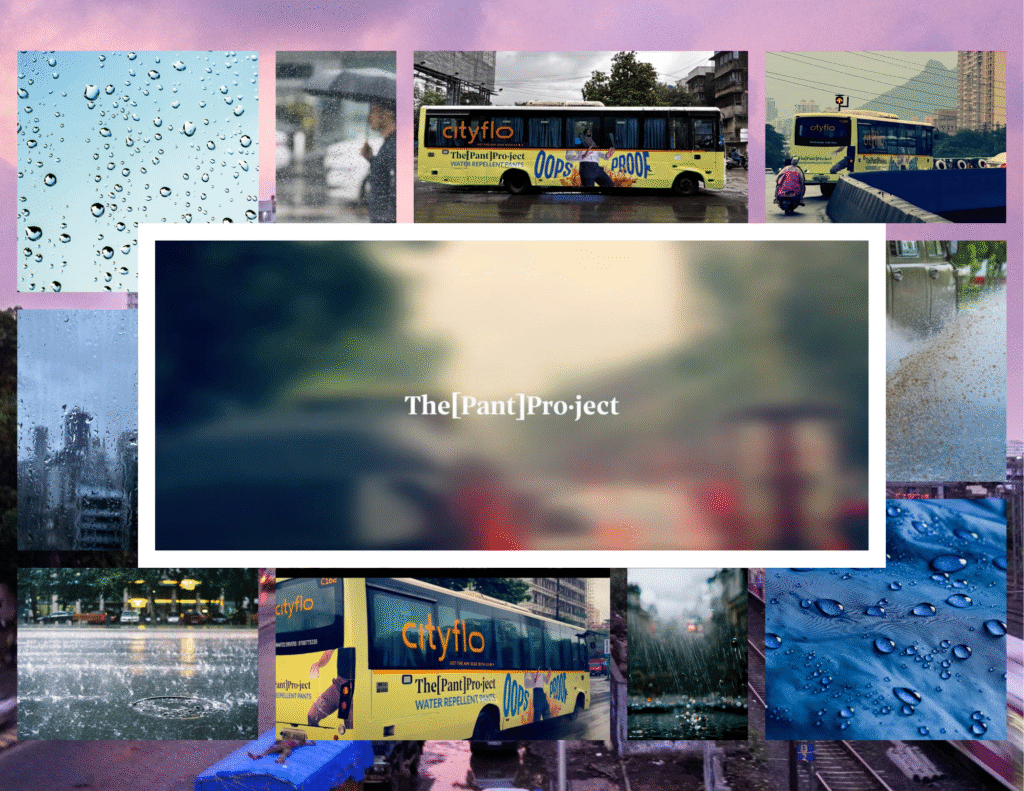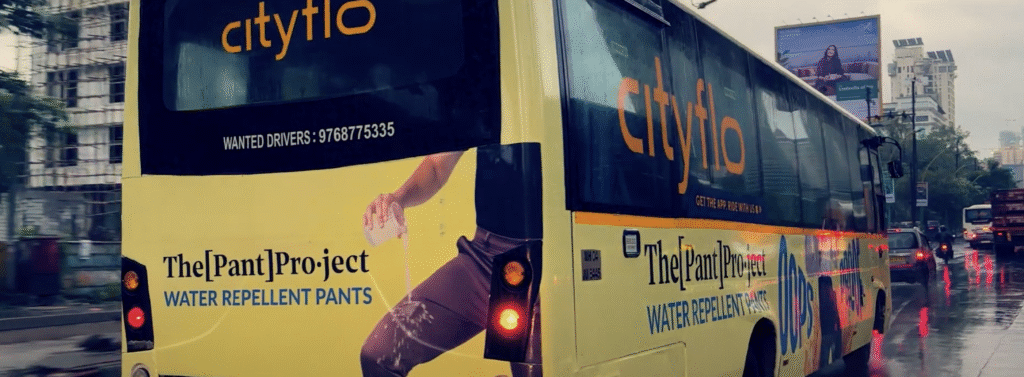
On a sweltering July morning in Mumbai, as the monsoon clouds gathered over the city’s perpetually congested streets, a curious sight began appearing on the routes between Andheri and Navi Mumbai. Buses—those stalwart vessels of urban resilience—were sporting a new kind of livery. Not the familiar advertisements for soap or mobile networks, but something altogether more peculiar: pants.
“Oops Proof,” declared the bold lettering across the sides of these mobile billboards, accompanied by images of water rolling off fabric like monsoon rain off a well-oiled umbrella. The Pant Project, a menswear brand that had built its reputation on functional clothing for India’s chaotic urban landscape, had chosen perhaps the most honest metaphor possible for its latest campaign.
If you’re going to sell trousers that promise to survive the daily assault of city life, why not advertise them on the very vehicles that embody that same philosophy of dogged persistence?
The campaign’s genesis, according to Sukita Tapadia, the brand’s Chief Marketing Officer, was refreshingly straightforward. “Buses felt like the most honest, hard-working metaphor for what these pants do—move through the mess, keep going, and never look out of place,” she explained during a conversation at the brand’s headquarters in Lower Parel. It’s a sentiment that reveals something rather profound about contemporary Indian advertising: the increasing sophistication of brands that understand their consumers not merely as purchasers, but as co-conspirators in the grand theatre of urban survival.
The Anatomy of Hyperlocal Ambition

The ‘Oops Proof’ campaign represents a fascinating case study in what marketing professionals euphemistically term “hyperlocal targeting.” But unlike the sterile precision of digital advertising, this initiative embraced the magnificent chaos of Mumbai’s public transport system. Large-format buses traversed key locations—Thane, Andheri, Goregaon, Powai, Navi Mumbai, BKC, Santacruz, South Bombay, Lower Parel, and Marol—creating what amounts to a rolling exhibition of functional fashion philosophy.
This initiative embraced the magnificent chaos of Mumbai’s public transport system, transforming buses into a rolling exhibition of functional fashion philosophy.
The timing was impeccable. Mumbai’s early monsoon arrival in 2025 provided the perfect backdrop for a campaign centred on water-repellent clothing. As any Mumbai resident will attest, the city’s relationship with rain is complicated—part romance, part existential dread. The Pant Project understood this duality, positioning their product not as mere clothing, but as urban armour for the daily battle against “monsoon splashes, chai spills, city chaos.”
Yet for all its contextual brilliance, the campaign’s execution revealed both the promise and the limitations of contemporary Indian marketing. The thirty-eight-second video that accompanied the bus campaign possessed a certain documentary authenticity, capturing Mumbai’s relentless energy whilst maintaining focus on the product’s functional benefits. But it also adhered to a rather predictable template—the sort of “built for real life” positioning that has become the default mode for functional fashion brands worldwide.
Digital Amplification and Its Discontents

Recognising that outdoor advertising alone rarely suffices in today’s media landscape, The Pant Project deployed what might generously be termed a “multi-channel approach.” The campaign extended to Instagram through the #OopsProof hashtag, accompanied by a community challenge that promised free pants worth up to ₹2,500 to the first hundred individuals who photographed the branded buses and shared them with appropriate tags.
This digital component reveals something interesting about the current state of brand engagement.
The mechanics are familiar to the point of tedium—spot, snap, share, win—yet they persist because they work, at least to a degree.
Research suggests that such Instagram challenges can boost engagement metrics by one to five per cent, though their impact on lasting brand loyalty remains questionable. The Pant Project’s decision to limit participation to the first hundred respondents was pragmatic, but it also highlighted the campaign’s modest ambitions in the digital realm.
The broader issue here is one that plagues much contemporary marketing: the tension between authentic local connection and scalable digital engagement. The Pant Project succeeded admirably at the former—their buses genuinely felt like part of Mumbai’s urban fabric. But their digital strategy lacked the innovation needed to transform casual viewers into committed advocates.
The Metaphor and Its Limits
Perhaps the most intellectually satisfying aspect of the ‘Oops Proof’ campaign was its commitment to metaphorical coherence. The bus—that most democratic of urban vehicles, carrying everyone from software engineers to street vendors across the city’s vast expanse—served as both medium and message. Like the water-repellent pants being advertised, Mumbai’s buses endure daily punishment whilst maintaining their essential function. They are, in a sense, the perfect embodiment of practical resilience.
But metaphors, however apt, can also become prisons.
By aligning so completely with the bus-as-urban-survivor narrative, The Pant Project risked confining itself to a rather predictable creative space.
While the broad functional promise—weatherproof clothing for monsoon season—finds echo in campaigns from brands like Zeel Climate Clothing’s “Be Rain Ready,” the similarities end at the surface. In truth, The Pant Project’s campaign achieved an unrivaled physical and cultural presence by transforming Mumbai’s buses into moving icons of urban endurance, embedding its message directly within the pulse of the city. By contrast, Zeel’s efforts remained rooted in static mediums—traditional billboards in fixed locations, and a single digital video ad built on familiar, utilitarian tropes. Zeel’s campaign, relying on conventional placements and standard demonstrations of water-repellent apparel, did not venture into the realm of mobile, high-frequency citywide advertising, nor did it attempt to integrate with daily urban commutes in any metaphorical or literal sense. The Pant Project’s strategic use of buses as both canvas and metaphor allowed its campaign to permeate the urban landscape, becoming part of commuters’ lived experience. In that light, any comparison with more conventional, fixed-location campaigns not only overstates the similarities but also understates the genuinely innovative ambition of ‘Oops Proof.’ Here, the difference is neither subtle nor semantic—it is the distinction between mere visibility and true, lived-out presence in the heart of the city.
Geographic Limitations and Missed Opportunities
India’s other monsoon-prone metros—Delhi, Bangalore, Chennai, Kolkata, Hyderabad, Thiruvananthapuram, and Kochi—remained largely untapped, each offering its own textured cultural context that could have been powerfully leveraged.
Delhi’s Metro culture, Bangalore’s technology-driven commuter base, Chennai’s distinctive blend of tradition and modernity, Hyderabad’s fast-growing cosmopolitan ethos, and the rain-soaked rhythms of Thiruvananthapuram and Kochi all represent fertile ground for contextual adaptation of the campaign’s core idea. By focusing so tightly on Mumbai, The Pant Project captured a city’s spirit but left the broader canvas of urban India largely blank—missing the chance to knit together a nationwide narrative of resilience tailored to these richly diverse, monsoon-battled cities
This geographic constraint reflects a broader challenge facing emerging Indian brands: the balance between deep local relevance and national scalability. The Pant Project’s Mumbai campaign succeeded because it understood and embraced the city’s specific character. But replicating that success across India’s diverse urban landscapes would require a more sophisticated understanding of regional nuances—and considerably more resources.
The Measurement Problem
One of the most revealing aspects of the ‘Oops Proof’ campaign was what it didn’t do: provide clear mechanisms for measuring its impact. Unlike digital advertising, with its reassuring metrics and attribution models, outdoor campaigns exist in a more ambiguous realm.
The Pant Project’s buses generated visibility and brand awareness, but translating that exposure into purchase behaviour remained largely a matter of faith.
The absence of QR codes, unique promotional codes, or dedicated landing pages meant that the campaign’s effectiveness had to be judged through proxy metrics—social media engagement, brand mention increases, and eventual sales correlation. This measurement gap is endemic to outdoor advertising, but it feels particularly acute for a digitally native brand like The Pant Project, which built its early success on data-driven e-commerce strategies.
Cultural Resonance and Creative Redundancy
The campaign’s greatest strength—its authentic connection to Mumbai’s urban reality—was also, paradoxically, a source of creative limitation.
The ‘oops’ insight, whilst relatable, follows a well-established pattern in functional apparel advertising.
From sportswear brands emphasising performance to outdoor clothing companies highlighting durability, the underlying message remains consistent: life is messy, but our products will help you manage.
This creative predictability doesn’t necessarily diminish the campaign’s effectiveness, but it does raise questions about differentiation in an increasingly crowded category. The Pant Project’s pants may indeed be superior to their competitors’, but the marketing language used to describe them has become almost interchangeable across brands.
Lessons in Authentic Marketing
Despite its limitations, the ‘Oops Proof’ campaign offers valuable insights into the evolving nature of Indian advertising. Most significantly, it demonstrates the continued power of contextual relevance.
In an era of programmatic advertising and algorithmic targeting, there remains something profoundly effective about a brand that genuinely understands its environment and speaks to it directly.
The campaign also highlights the importance of metaphorical thinking in marketing. By choosing buses as their canvas, The Pant Project created a narrative coherence that extended beyond mere product placement. The medium became part of the message, creating a more memorable and meaningful brand experience.
Recommendations for Enhancement
The ‘Oops Proof’ campaign, whilst solid in its execution, pointed towards several opportunities for improvement.
A more sophisticated digital integration—incorporating weather-based messaging, location-specific content, or augmented reality experiences—could have bridged the gap between offline exposure and online engagement more effectively.
The community challenge, rather than being limited to Instagram and capped at a hundred participants, could have been expanded across multiple platforms and designed with viral mechanics in mind. Creating tiered challenges with varying reward structures might have sustained engagement beyond the initial campaign period.
Most importantly, the campaign would have benefited from a more robust measurement framework. Partnership with Mumbai’s transit authorities for passenger data, implementation of unique tracking codes, or regular consumer surveys along bus routes could have provided clearer attribution and optimisation opportunities.
The Broader Implications
The Pant Project’s Mumbai experiment reflects broader trends in Indian marketing—the move towards hyperlocal relevance, the integration of offline and online channels, and the increasing sophistication of domestic brands. But it also reveals the challenges facing Indian companies as they attempt to scale beyond their initial markets whilst maintaining the authenticity that drove their early success.
The campaign succeeded because it felt genuine. The buses, the monsoon timing, the functional messaging—all combined to create a cohesive narrative that resonated with Mumbai’s commuters.
But replicating that success across India’s diverse urban markets will require more than simple adaptation. It will demand a deeper understanding of local cultures and the creative courage to develop genuinely differentiated approaches for each market.
The Future of Functional Fashion Marketing
As functional clothing becomes increasingly mainstream in India, brands like The Pant Project will need to move beyond purely practical messaging to create more emotional connections with consumers.
The ‘Oops Proof’ campaign’s focus on urban resilience was a step in this direction, but future campaigns might explore themes of confidence, transformation, or community belonging.
The campaign also suggests the potential for more sophisticated brand partnerships. Collaboration with transit authorities, weather services, or local cultural institutions could create campaigns that feel less like advertising and more like public service—enhancing both brand credibility and consumer utility.
Conclusion: The Art of the Possible
The Pant Project’s ‘Oops Proof’ campaign represents both achievement and aspiration. It succeeded in creating genuine local relevance and metaphorical coherence, demonstrating that thoughtful marketing can still cut through the noise of contemporary advertising. But it also revealed the constraints facing emerging Indian brands—limited resources, measurement challenges, and the tension between local authenticity and national scalability.
Ultimately, the campaign’s legacy may lie not in its immediate commercial impact, but in its demonstration of how brands can create meaningful connections with their consumers by understanding and reflecting their daily realities.
In a marketing landscape increasingly dominated by algorithmic targeting and programmatic placement, there remains something refreshingly human about a brand that chooses to tell its story on the sides of buses navigating Mumbai’s chaotic streets.
The buses, like the pants they advertised, continue their journey through the city—moving through the mess, keeping going, never looking out of place. Whether that metaphor will prove robust enough to carry The Pant Project to national prominence remains to be seen. But for now, at least, it provides a compelling example of marketing that understands its audience not as demographic segments, but as fellow travellers in the grand adventure of urban life.
This analysis is based on publicly available information about The Pant Project’s ‘Oops Proof’ campaign, industry research on transit advertising effectiveness, and interviews with marketing professionals familiar with the Indian fashion industry.
P.S:
If Mumbai’s buses are the city’s arteries, the local trains are its lifeblood. Had the ‘Oops Proof’ campaign anchored itself on these iconic trains, it might have achieved an even truer reflection of the city’s pulse—and unlocked remarkable creative possibilities.
Consider an alternative campaign theme: “Perfect Fit for Every Journey”—positioning the pants as reliable and comfortable as the Mumbai Local itself, always there for every commuter. The creative landscape becomes immediately richer: diverse commuters wearing the pants across train scenarios, from Churchgate to Virar, office-goers to vendors, rush hour to relaxed evenings.
The installations alone would transform the commute: select train compartments wrapped in campaign colours, seat covers bearing witty comfort-focused one-liners, floor stickers at train doors declaring “Step Into Comfort.” Interactive elements—QR codes for instant discounts, virtual fitting rooms, “Spot the Pant” contests where commuters share train selfies—could bridge the offline-online engagement gap that the original campaign struggled to close.
Taglines like “Pants That Move With Mumbai” or “From Rush Hour to Relaxed Evenings—Pants That Keep Up With Mumbai” speak directly to the lived reality of millions of daily commuters. The social extension—#MumbaiMovesInStyle—invites authentic storytelling from Mumbai’s micro-influencers and everyday train travelers.
Such a campaign wouldn’t merely advertise functional clothing; it would become part of Mumbai’s daily ritual—embedding the brand within the city’s most intimate, shared experience of movement, endurance, and collective journey. The missed opportunity isn’t just about reach or frequency; it’s about becoming woven into the fabric of how Mumbai sees itself.
Sources:
- https://ppl-ai-file-upload.s3.amazonaws.com/web/direct-files/attachments/10660488/ed79bf46-3dc1-4c95-b7e4-617876e1c238/Comprehensive-Analysis_-The-Pant-Project-s-Oops-P.docx
- https://ppl-ai-file-upload.s3.amazonaws.com/web/direct-files/attachments/images/10660488/e20394c9-2f6a-4142-8d11-9c59a1089ee3/SBs-Style-Guide.jpg?AWSAccessKeyId=ASIA2F3EMEYEQW5DX6KQ&Signature=o2hteGhHaIFEORmxX01chBRLKfY%3D&x-amz-security-token=IQoJb3JpZ2luX2VjEJH%2F%2F%2F%2F%2F%2F%2F%2F%2F%2FwEaCXVzLWVhc3QtMSJIMEYCIQDnmbFXBoOGfGaplm7obWj4sYimUkJhd5B8qrVe7IDVHAIhAJQoKUi5VF3SUZaiJpuNAzGSLZ%2Fp5ARvsxiDj3lgjC%2BbKvoECLr%2F%2F%2F%2F%2F%2F%2F%2F%2F%2FwEQARoMNjk5NzUzMzA5NzA1IgyFra5hM4wuELxiMfoqzgRZ%2FkWcAy28IMP60rSGIjuyl%2BDn5FDm6eFLmkaQRMNrtEveSh0pw%2FBBbHV9QDvQ4Y8b08%2Bm0lwLVBS9YU1lKQc5TjymPANVGNZaT%2BtEGyQjh4%2FwDjGUg8xU%2FFJ7ePxxDtS7G6EzEWLzuVUaoz8N0kwJDYJvicw9P%2F1%2FlhAOUJ0LtfOZ0slYgxsCmlq3mIaHjzDD65Mt5WEMVySj1OhkRcqhsd8ioOIeqY5ykZie55PtrUYxEGbJ3YizLiuNhK%2FUQmROOMYlH14vrFT1nz7lt%2Fzz%2BV8fC89d2nwNgyHB%2FjLyNHJB2LeivYC1msUbI9cttO%2BpXItMdVROIQ%2B1GpztjS7K5Q22E5qN%2FGPsWIs0gORXBPVl3u8%2B3thIrSgzgHY5BM210t%2FBkPmkdeHpZxvl2NMD%2B5bVpgO%2FQCLnclqbZhoR52ZhjsxOh61hvAi0skas0zQnXrB%2Fumgo%2FH4xS9kYBPP9Gt6U2ZwfmKsMMBjdBl%2Fc911cIkIq6DClkFGqFjt3b38joy2xF8bpSl1x6f96wlpFXs99vB2ENX53Xndx8P4R2Voewa0j5J8t5HueaM6panLFydiFLFNUaE16tBPlRwCN61AipGKu7FhOPQulympYQBYqS7xG6jLAIx1omPrOqp1ul%2F%2FzrYvA%2F%2Fp0XR2Fnq949aLvZwRTWr9fj%2FND0NEy3rxsYZLfb4DgFQuU4y6%2FFHrBsGBBOkMZmGfABH7zuVEXNcA67sWWgTA%2BleoXIC37ylxLXwXha4BJC%2BmrnmeB4j%2B%2FHIsJfdvNZPgCxNKDczCAuafEBjqZAQIo3Zp2%2F9aFmUO26q7nIKONGhWfuD7y9kQHWlWQwUDfmtb1iC%2BWIickKQnfsy9mholJEJ3n%2FCpoGMnbja4hkAYaP2Y0n24Z4iK6ozPhOI8eEhykOr%2Bn7%2FRx3sH%2B5Yx0%2B4AM2sj%2BhzM6fd19sBCplx4RR2mVGx5zeT0w65mcX50LQB9GINMJXDZmATO4h8qKDu30q4SOhszsVg%3D%3D&Expires=1753868199
- https://en.wikipedia.org/wiki/The_New_Yorker
- https://www.newyorker.com/culture/the-weekend-essay/writing-as-transformation-louise-gluck
- https://bird.marketing/blog/digital-marketing/guide/content-marketing/long-form-content-benefits-best-practices/
- https://postcardsbyelle.substack.com/p/longform-articles-and-essays-101
- https://www.newyorker.com/books/this-week-in-fiction/danielle-dutton-12-05-22
- https://www.fastfwd.com/long-form-content-for-seo/
- https://shorthand.com/the-craft/longform-journalism-is-on-the-rise/index.html
- https://overland.org.au/2013/12/really-whats-so-great-about-the-new-yorker/
- https://www.seoptimer.com/blog/long-form-content/
- https://theconversation.com/from-satire-to-serious-journalism-how-the-new-yorker-has-shaped-a-century-of-thought-249376
- https://www.newyorker.com/magazine/2013/01/14/structure
- https://www.singlegrain.com/blog/ms/long-form-content-seo/
- https://www.newyorker.com/about/us
- https://www.newyorker.com/culture/cultural-comment/do-we-write-differently-on-a-screen
- https://www.foleon.com/blog/long-form-content-writing-best-practices
- https://www.britannica.com/topic/The-New-Yorker
- https://www.publicbooks.org/ditching-the-new-yorker-voice/
- https://developers.google.com/search/docs/fundamentals/seo-starter-guide
- https://en.wikipedia.org/wiki/Long-form_journalism
- https://www.newyorker.com/fiction-and-poetry
- https://www.newyorker.com/culture/2022-in-review/first-lines-to-remember-in-this-years-new-yorker-fiction
- https://www.investigative-manual.org/chapters/writing-the-story/1-how-to-write-your-story/1-3-1-story-structure-and-styles/
- https://briefcatch.com/articles/ten-lessons-from-the-new-yorker/
- https://www.newyorker.com/humor/daily-shouts/opening-lines-rewritten-for-a-pandemic
- https://www.numberanalytics.com/blog/art-of-anecdotal-leads-in-journalism
- https://www.youtube.com/watch?v=xHsTgonU0yY
- https://www.newyorker.com/magazine/2020/11/23/first-lines-of-rejected-modern-love-essays
- https://spcollege.libguides.com/c.php?g=254319&p=1695314
- https://magazine.workingnotworking.com/magazine/2016/6/14/bcpwb84gdwjho0333ltpyio5plhb7s
- https://www.newyorker.com/books/page-turner/lost-in-translation-what-the-first-line-of-the-stranger-should-be
- https://en.wikipedia.org/wiki/Article_structure
- https://www.newyorker.com/books/this-week-in-fiction/han-ong-01-20-25
- https://www.newyorker.com/magazine/2024/07/08/opening-theory-fiction-sally-rooney
- https://socialsci.libretexts.org/Bookshelves/Communication/Journalism_and_Mass_Communication/The_American_Journalism_Handbook_-_Concepts_Issues_and_Skills_(Zamith)/10:_Creating_Journalistic_Content/10.02:_Story_Structures
- https://www.newyorker.com/books/page-turner/how-i-get-to-write
- https://www.newyorker.com/magazine/2019/12/30/lines
- https://library.fiveable.me/key-terms/hs-journalism/anecdotal-lead
- https://www.newyorker.com/books/page-turner/cheevers-art-of-the-devastating-phrase
- https://www.newyorker.com/magazine/2024/09/09/every-newspaper-obituarys-first-paragraph
